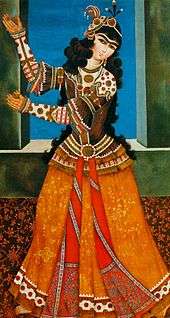Zill
Zills, also zils or finger cymbals (from Turkish zil, "cymbals"), are small metallic cymbals used in belly dancing and similar performances.[1] They are called sājāt (صاجات) in Arabic.[2][3] They are similar to Tibetan tingsha bells. In western music, several pairs of zills can be set in a frame to make a tambourine.


Features
A set of zills consists of four cymbals, two for each hand. Zills come in a range of sizes, the most common having a diameter of about 5 cm (2 in). Different sizes and shapes of zills will produce sounds that differ in volume, tone and resonance. For instance, a dancer performing with an orchestra will use a larger zill with more volume, whereas many belly dancers may use a zill with a more delicate sound, depending on the venue and whether their music is live or recorded, amplified or acoustic. American Tribal dancers typically use a much larger zill with a more mellow tone.
Zill manufacturers commonly use brass rather than the bronze used for larger cymbals, and may design their own brass alloys specifically to achieve particular sound qualities. They may plate some zills in order to give a specific color to them. Zills vary in appearance and may be shiny, dull, plain or engraved.
Before the invention of elastic, zills were tied onto the fingers with leather strips. Modern cymbalists use elastic to secure the zills, one to the thumb and one to the middle finger of each hand. Many zills have two slots to allow the threading of the elastic through the zill, allowing greater control of the instrument. Others have a single hole, allowing greater wobble and creative use with speed.
Zills played as idiophones, two on each hand, can be played in many ways to produce a wide and subtle range of sound, from quiet clicking, bell-like ringing, muted cupped sounds, loud clacks, and even a small range of pitch change.
Zills belong to the family of instruments used in Ottoman military bands and also occasionally appear as part of Western orchestral or other musical performances. In these cases musicians usually just call them finger cymbals and use them to obtain a ringing sound with "Middle Eastern" associations. Percussionists who are not exclusively cymbalists sometimes play finger cymbals by striking one cymbal with a drumstick, or by holding one cymbal in each hand by gripping the strap between the thumb and the index finger, and striking the rims together. They tend to use zills for occasional flourishes in the music rather than for complex rhythms and sounds. For more intricate rhythms, an orchestral player might attach a cymbal to both his thumb and first finger. Then placing that hand between his other hand and knee, the player will alternate between striking the knee and the opposite hand. Each of the motions produce one articulation of the cymbals.[4]
There are many rhythms in belly dancing music that can be spelled out in finger cymbal playing.[5] The style of playing varies from one style and era of dance to the next.
- triples, not to be confused with "triplets": (left/right/left/pause – “giddyup, giddyup, giddyup”)
- quads: (L/R/L/R/no pause)
- beledi: (dum/dum/tek-a-tek/dum-tek-a-tek)
- chiftatelli: (dum/dum/tek-a-tek/dum/dum/dum – “John went to the sea; caught. three. fish.”)
- ayoub: (dum/a-tek-tek – “buy more shoes, and…buy more shoes, and . . .,”)
- bolero" (dum/tek-a-tek-tek/dum/dum/dum/dum – “I want to be a belly dancer”)
- In the count of the beat, the gallop is played as "and a ONE, and a TWO..." etc. It can also be played as right/left/right/rest. Many teachers recommend thinking of it as "dominant hand"/"non-dominant hand"/"dominant hand"/rest.
Zills are also used in Sufi music, and may be played arrhythmically in a lyrical flow of sound for meditations and sound healing.
See also
References
- Zill 2017.
- Sawa, George Dimitri (2015-04-30). An Arabic Musical and Socio-Cultural Glossary of Kitāb al-Aghānī (in Arabic). BRILL. ISBN 9789004279094.
- Koskoff, Ellen (2008). The Concise Garland Encyclopedia of World Music: The Middle East, South Asia, East Asia, Southeast Asia. Routledge. ISBN 9780415994040.
- Peinkofer & Tannigel 1988, p. 145.
- Cymbal Symbolism http://bellydancingdiva.com/2009/09/cymbal-symbolism/
Sources
- "The American Heritage Dictionary entry: Zill". The American Heritage Dictionary of the English Language. Houghton Mifflin Harcourt. 2017.
- Peinkofer, Karl; Tannigel, Fritz (1988) [1976]. Handbook of percussion instruments : their characteristics and playing techniques, with illustrations and musical examples from the literature. Mainz / London: Schott. OCLC 604102910.CS1 maint: ref=harv (link)
Further reading
- Foreman, Kelly Marie (1994). Zills, the idiophone of the Middle Eastern belly dancer : their history, pedagogy, techniques of playing, and role in the context of bodily expression (MA thesis). Kent State University. OCLC 32361787.CS1 maint: ref=harv (link)

